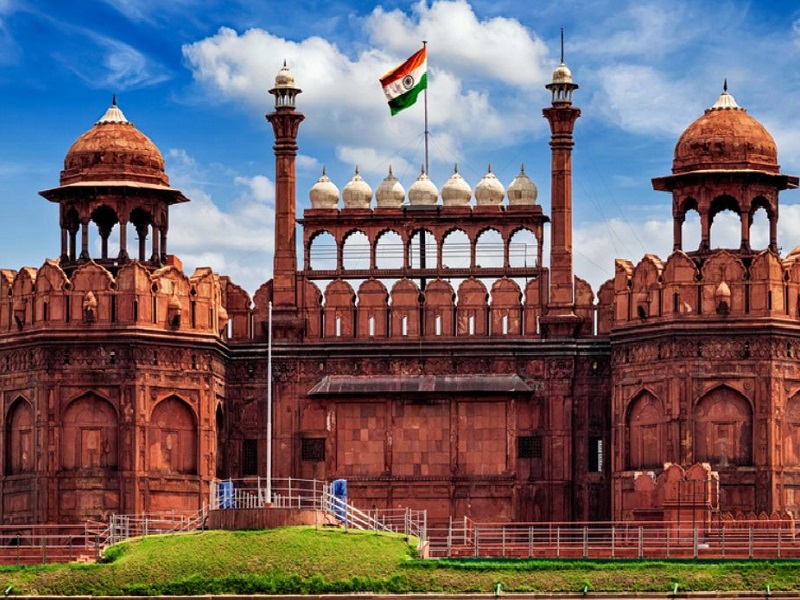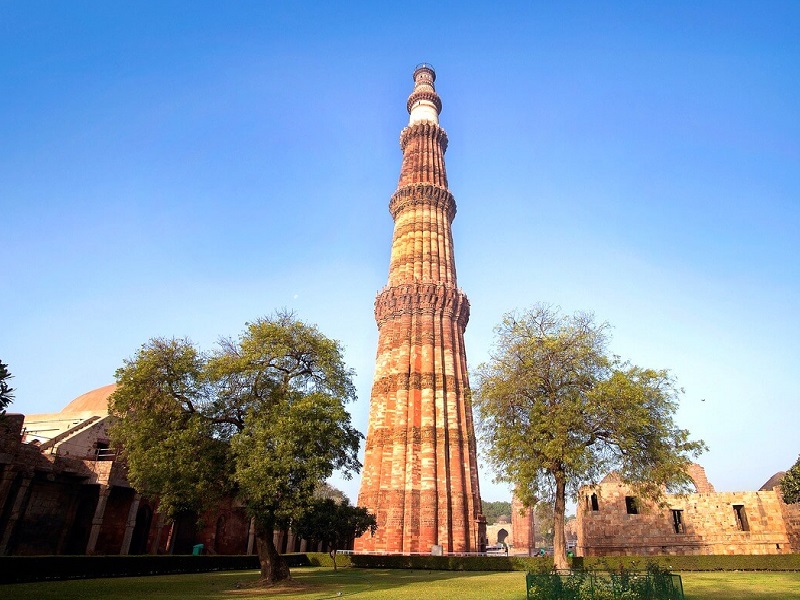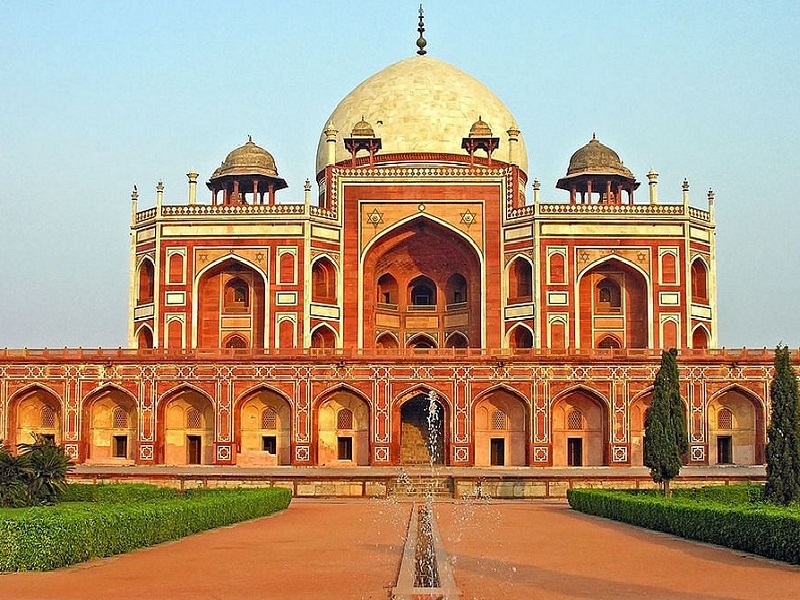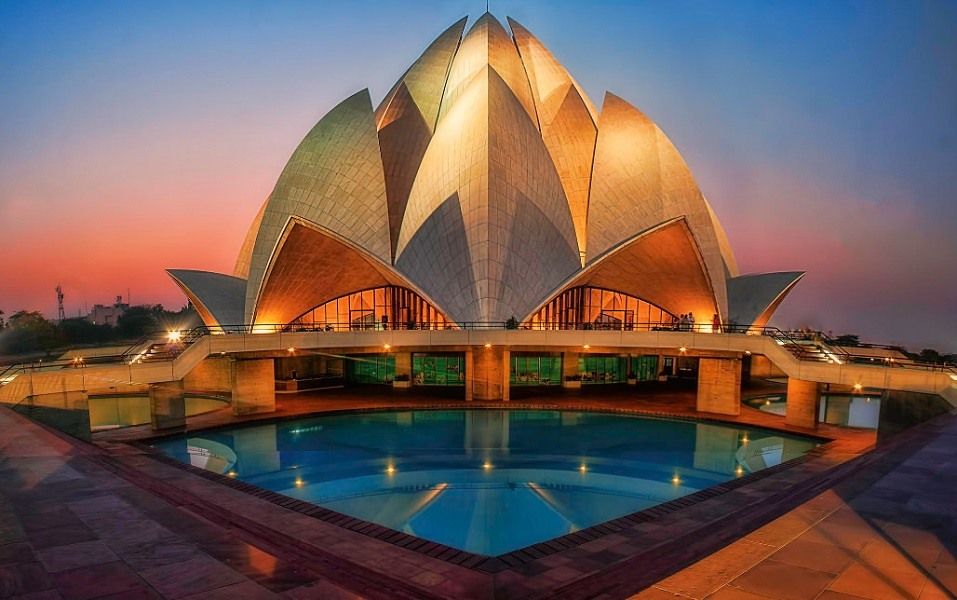Delhi, the capital of India, stands as one of the nation’s oldest cities and ranks among the fastest-growing urban centers globally. Historically referred to as Indraprastha or Hastinapura, the city’s captivating blend of cultural heritage and vibrant markets draws both domestic and international visitors as part of various India tour packages. This dynamic metropolis boasts three UNESCO World Heritage Sites, 174 National Monuments, 30 museums, 20 prominent temples, and countless lesser-known gems. With its beautifully landscaped gardens, bustling markets, and delectable street food, one can grasp the essence of this vibrant megalopolis. While it may be challenging to experience everything in a short time, a three-day visit is sufficient to appreciate the key attractions and immerse oneself in the city’s atmosphere. Refer to our suggested Delhi 3-day trip itinerary to guide you in exploring one of the most historically significant cities in the world.
Jantar Mantar
Jantar Mantar, commonly referred to as the Delhi Observatory, is a national monument located on Parliament Street in Delhi. Constructed in 1724 AD, it stands as one of the prime places to visit in Delhi, particularly appealing to enthusiasts of astronomy. This site is one of five astronomical observatories in India established by Maharaja Sawai Jai Singh II of Jaipur while the other four are Jaipur, Ujjain, Varanasi, and Mathura. The primary objective of Jantar Mantar was to compile astronomical tables that would facilitate the prediction of the timing and movements of celestial bodies, including the sun, moon, and various planets. It is a notable inclusion in Delhi tour packages, featuring 13 astronomical instruments, such as the Samrat Yantra, Ram Yantra, Jaya Prakash, and Mishra Yantra. The entire edifice is constructed from stone and marble.
Book Here : Golden Triangle Tour Packages
Birla Mandir
Lakshmi Narayan Temple, commonly referred to as Birla Mandir, was established by the Birla family in 1939. Dedicated to Lord Vishnu & Goddess Lakshmi, it is one of the first temples built by the Birlas in India and among the must-include places in Delhi Pilgrimage Packages. The three-storeyed temple was built in the Nagara style of architecture. Spanning 7.5 acres, the temple complex is richly embellished with intricate carvings that illustrate various scenes from Hindu mythology. The vimana above the sanctum sanctorum rises to a height of 165 feet, while the surrounding towers reach 116 feet. Within the main temple, one can find statues of Lord Narayan and Goddess Lakshmi, alongside smaller shrines dedicated to Lord Shiva, Lord Ganesh, and Hanuman. Additionally, there is a shrine honoring Lord Buddha, adorned with frescoes that depict his life and teachings. The temple’s aesthetic appeal is enhanced by artificial landscapes and cascading waterfalls. As one of Delhi’s prominent attractions, it draws thousands of devotees during major Hindu festivals such as Janmashtami and Holi.
Must Visit : Hill Stations near Delhi
Jama Masjid
Jama Masjid, situated in proximity to the renowned Red Fort, ranks among the largest mosques in India and one of the top historical sites in Delhi. Commissioned by Shah Jahan between the years 1644 and 1656, the mosque features three grand entrances, four towers, and two minarets, each standing 40 meters tall, crafted from red sandstone and white marble. Elevated on a red sandstone platform approximately 30 feet above ground, the mosque encompasses an area of 1200 square meters. The mosque’s floor is entirely laid with white and black marble, resembling a prayer mat by Islamic tradition. The outer courtyard, which is rectangular and measures 75 meters by 66 meters, can accommodate approximately 25,000 worshippers simultaneously. The prayer hall is embellished with arched marble designs that narrate the mosque’s rich history. Additionally, the cabinet located at the north gate of Jama Masjid houses a collection of relics associated with Muhammad, including a Quran inscribed on deerskin, a strand of the prophet’s red beard, his sandals, and his footprints embedded in a marble slab.
Book Here : Delhi Heritage Tours
Red Fort

Located on the western bank of the River Yamuna, the Red Fort, also known as Lal Qila, stands as one of the most significant historical sites to explore within Delhi packages. Initially referred to as Quila-i-Mubarak, this fort was constructed by Shah Jahan between the years 1638 and 1648. It is encircled by a rubble stone wall that contains several museums. The Red Fort is designed in an octagonal shape, featuring extensive walls on both the eastern and western sides, and is surrounded by a deep, imposing moat. Recognized as a UNESCO World Heritage Site in 2007, the fort boasts two principal entrances: the Lahore Gate and the Delhi Gate, with the Lahore Gate serving as the main point of entry. This gateway is part of a grand stone fortification and is crafted from pink sandstone. Visitors have the opportunity to attend a sound and light show held every evening, which vividly portrays the history of the Red Fort. Additionally, this site is notable as the location from which the Prime Minister addresses the nation annually on Independence Day celebrated on August 15.
Also Read : Best Heritage Sites in India
Akshardham Temple / Swaminarayan Temple
Situated along the banks of the River Yamuna, Akshardham Temple, also known as Swaminarayan Temple, stands as a significant Hindu temple that should be included in any Delhi 2-day Trip or 3-day itinerary. Recognized in the 2009 edition of the Guinness World Records as the largest Hindu temple globally, it is dedicated to Lord Swaminarayan. The term “Akshardham” translates to the abode of the supreme lord, and the temple exemplifies exquisite Hindu architectural design. Constructed in 2005, the temple complex spans an impressive 100 acres and features numerous smaller structures surrounding the main monument. This principal edifice, crafted from Rajasthani pink sandstone and Italian Carrara marble, reaches a height of 141 feet, a width of 316 feet, and a length of approximately 370 feet, supported by 234 intricately carved pillars. It also boasts 11 grand mandapas (domes) and beautifully adorned arches, housing over 20,000 statues of various Hindu deities. Visitors can explore an art gallery, enjoy a musical fountain, and watch a film about Swaminarayan’s life in an IMAX theater. Another notable highlight within the temple complex is the World Peace monument.
Book Here : Delhi Family Packages
Qutub Complex

The Qutub Complex is a renowned heritage site on Aurobindo Marg near Mehrauli in Delhi. This complex is home to the iconic Qutub Minar, recognized as the tallest tower in India and a key attraction in Delhi leisure packages. Designated as a UNESCO World Heritage Site in 1993, its construction was initiated by Qutub-ud-Din Aibak in 1199 AD to allow the Mu’zzin (caller) to announce prayer times. Aibak completed the first storey, while his successor and son-in-law, Shamsud-Din Iltutmish (AD 1211-36), added three additional storeys. The minaret, constructed in the Indo-Islamic architectural style, features a base diameter of 14.32 meters and tapers to approximately 2.75 meters at the top, reaching 72.5 meters (234 feet). The first three storeys are crafted from red sandstone, while the fourth and fifth storeys are composed of marble and sandstone. Each storey is adorned with a projecting balcony, supported by intricately designed stone brackets featuring a honeycomb pattern. Additionally, the Qutub Complex boasts other notable attractions, such as the Quwwat-ul-Islam Mosque and the Iron Pillar.
Must Visit : Heritage Sites near Delhi
India Gate
Located at the eastern end of Raj Path in New Delhi, India Gate, initially known as the All India War Memorial, serves as a tribute to the 70,000 Indian soldiers who perished during World War I. The memorial features the names of over 13,516 British and Indian soldiers who lost their lives in the Afghan War of 1919 on the Northwestern Frontier. Designed by the renowned British architect Edward Lutyens, the Duke of Connaught laid the foundation stone in 1921. The monument’s design is reminiscent of the French war memorial, the Arc de Triomphe. Standing at a height of 42 meters characterized by its arched architecture, India Gate is a prominent structure in Delhi, among the top places to visit in India. Subsequently, the Amar Jawan Jyoti Memorial was established after India gained independence. An eternal flame burns continuously beneath the arch, serving as a poignant reminder of the soldiers who sacrificed their lives during the Indo-Pakistan War in December 1971.
Book Here : Delhi Couple Packages
National Museum
The National Museum, overseen by the Ministry of Culture, stands as one of the largest museums in India and among the prominent tourist places in Delhi. Established on 15th August 1949, it showcases a vast array of artifacts that span from prehistoric times to the modern era. The museum is home to approximately 200,000 exquisite artifacts, representing both Indian and international heritage, with some items dating back over 5,000 years. Its remarkable collection encompasses various categories, including archaeology, arms and armor, decorative arts, jewelry, manuscripts, paintings, and artifacts from the Harappan Civilization. A notable feature of the museum is its film presentations that highlight India’s artistic heritage. Among its most visited sections is the Buddhist Art area, which contains several revered relics of Lord Buddha discovered in the Basti District. Additionally, there is a dedicated space for Indian miniature paintings, showcasing styles such as Deccani, Pahari, Central Indian, and Rajasthani, with origins ranging from 1000 AD to 1900 AD. The National Museum also houses the National Museum Institute of History of Arts, Conservation, and Museology, which is now recognized as a university.
Book Here : Delhi Honeymoon Packages
Humayun’s Tomb

Humayun’s Tomb stands out as one of the must-see UNESCO World Heritage Sites during your Delhi 3-day tour. Built-in 1562 by Hamida Banu Begum, the wife of Humayun, this striking mausoleum is the final resting place of the second Mughal Emperor and the father of Akbar. The architectural design, crafted by the Persian architect Mirak Mirza Ghiyath, draws inspiration from the Gur-e Amir, the tomb of the Mughal ancestor Timur in Samarkand. This exquisite example of Mughal architecture showcases Persian influences, featuring a magnificent dome made of marble. The tomb is octagonal and flanked by two grand double-storied gateways to the west and south. Nestled within a sprawling 30-acre garden known as the Char Bagh, Humayun’s Tomb is recognized as the first garden tomb in the Indian subcontinent. The complex is rich with many smaller monuments, including the tomb of Humayun’s wife, the Afsarwala tomb and mosque, the Isa Khan Tomb, Bu Halima Garden, and the Nila Gumbad, each adding to the historical significance and beauty of the site.
Also Read : Best Wildlife Sanctuaries near Delhi
Lodi Garden
Lodi Garden is a historical complex that encompasses various significant monuments, including tombs, mosques, and a bridge, associated with the Lodi and Sayyid dynasties in Delhi, among the most visited tourist places near Jaipur. Constructed by the Sayyids and Lodis during the 15th and 16th centuries, the garden was landscaped in 1936 by Lady Willington, the spouse of the Marquess of Willington, who served as the Governor-General of India under British rule. Initially named Lady Willington Park, it was renamed Lodi Garden following India’s independence in 1947. Spanning 90 acres, Lodi Garden features expansive lawns, numerous trees, plants, and flowers, all set against a backdrop of exquisite monuments. Notable structures within the garden include the Tomb of Mohammed Shah, the Tomb of Sikandar Lodi, Shisha Gumbad, Bara Gumbad, and Athpula Bridge. Recently, a Bonsai park was introduced, showcasing a remarkable collection of bonsais, along with a butterfly conservatory, herbal garden, lily pond, and rose garden. The garden also contains several small lakes that attract a variety of birds, including owls, kingfishers, hornbills, kites, mynahs, parakeets, and babblers.
Book Here : Delhi Luxury Tours
Lotus Temple / Bahai Temple

Located at Bahapur Hill, the Lotus Temple is one of the most prominent places to visit in Delhi packages. Commonly referred to as the Bahai Temple or the Bahai House of Worship, its name derives from its distinctive lotus-shaped design. The temple was constructed by adherents of the Bahai Faith, with building efforts commencing in 1980 and concluding in 1986 at a cost of 10 million. Notably, the Lotus Temple does not feature idols, religious imagery, or other religious symbols. Crafted from white marble sourced from Penteli Mountain in Greece, it serves as a serene environment for meditation, tranquility, and enlightenment. Encompassed by 26 acres of beautifully landscaped gardens, the temple boasts 27 free-standing white petals made of marble, arranged in clusters of three to create a nine-sided structure. It attracts approximately three and a half million visitors annually, making it one of the seven Bahai Houses of Worship globally and one of the most frequented sites worldwide, warranting consideration for inclusion on the UNESCO list.
Book Here : Delhi Wildlife Packages

